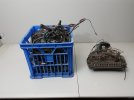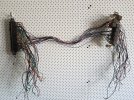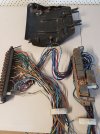Steve Thomas
True Classic
One of my 1980 Australian delivered Series 2 cars [Series 1.5 4spd, 1300] came with its electrical system in a milk crate. The other came with no electrical system at all...

Starting point is stripping the fuse box.

Pulled the fuse block and relay mount bracket and hung them up. Interesting. There are a fair few wires that go only from a fuse to a relay and yet are about 700mm long.

I will be taking the excess wire out - will go down to about 100mm from 700mm. The other thing I will do is re-route/re-lay the wiring at both the fuse block and relay group. The wires that come out of a fuse and go off to the car somewhere have to pass under the relay group. They should be on the bottom row of the fuse block so they can lay flat down on the tray. The wires that go from a fuse to a relay will be at the top on the fuse block end and the front at the relay end. The wires that run from a relay go off to the car somewhere will be at the back of the relays. It won't be as black and white as that - but those are the principles I will follow. The end point is less wire and much more space efficient packaging.

Starting point is stripping the fuse box.

Pulled the fuse block and relay mount bracket and hung them up. Interesting. There are a fair few wires that go only from a fuse to a relay and yet are about 700mm long.

I will be taking the excess wire out - will go down to about 100mm from 700mm. The other thing I will do is re-route/re-lay the wiring at both the fuse block and relay group. The wires that come out of a fuse and go off to the car somewhere have to pass under the relay group. They should be on the bottom row of the fuse block so they can lay flat down on the tray. The wires that go from a fuse to a relay will be at the top on the fuse block end and the front at the relay end. The wires that run from a relay go off to the car somewhere will be at the back of the relays. It won't be as black and white as that - but those are the principles I will follow. The end point is less wire and much more space efficient packaging.
Last edited:
